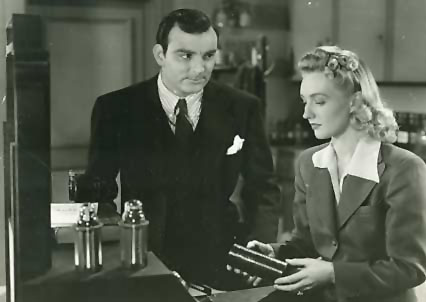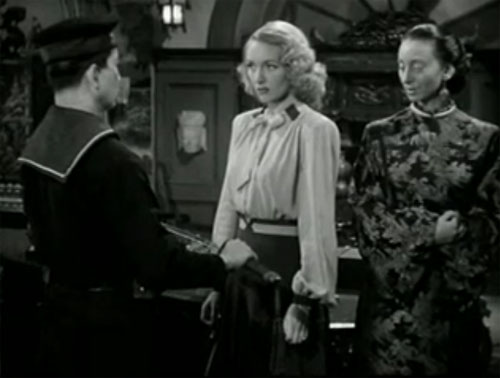February 23rd, 1916 — May 27th, 1993

Above: Jan Wiley in her third serial, Secret Agent X-9 (Universal, 1945).
Jan Wiley was an alluring, rather coolly sophisticated blonde beauty, who could switch from aloofness to vivacious affability with ease; she might easily have found a niche in feature films, playing mysterious and morally ambiguous ladies in “film noirs.” Such an actress, lacking the ingenuousness of the typical serial heroine, would seem an odd choice for a cliffhanger leading lady, but Wiley proved an excellent heroine in her few ventures into the chapterplay genre, landing unusual parts well-suited to her distinctive personality.
Jan Wiley was born Harriet Frances Wiley in Marion, Indiana; the spelling of her first name is sometimes given as “Harryt.” She graduated high school in Indianapolis in 1933, and began working as a model in New York in 1936, first at the famous department store Saks Fifth Avenue, and then at John Powers’ modeling agency, where, like fellow serial heroines Kay Aldridge and Linda Stirling, she modeled for advertising photographs and soon came to Hollywood attention, making her screen debut in 1937. She made this debut under the name of Harriet Brandon in the RKO musical/comedy/revue New Faces of 1937, in which, in company with other budding starlets, she was given a glorified cameo to introduce her to audiences. She followed this film up with a small credited supporting role in RKO’s drama Stage Door, which starred Katherine Hepburn. After this initial foray in Hollywood, Wiley evidently decided to acquire more acting experience before continuing her movie career. She returned to the East Coast, where in June 1939 she and her actor husband, Wister Clark, joined the Mountain Theater stock company, a theatrical troupe based in Braddock Heights, Maryland, in June 1939. A press clipping on Clark has him appearing on the New York stage prior to his signing by the Mountain Theater, making it likely that Wiley was also doing New York stage work between her time in Los Angeles and Maryland. In any event, both of them returned to the New York area at the end of the summer of 1939, departing Maryland for an engagement on the Connecticut stage. In April, 1940, Wiley and her husband were living in New York City, but by October of that same year they had returned to Los Angeles.
Wiley had used Harryt Brandon as her stage name in Maryland, but adopted Jan Wiley as her new acting moniker upon her return to California. Following this return, she played a few more bits in RKO’s A-features (including Citizen Kane) in 1940 and 1941, and then started receiving leading roles in B-movies like the “Range Busters” western Tonto Basin Outlaws (Monogram, 1941) and in movie serials, beginning with Dick Tracy vs. Crime Inc (Republic, 1941). Jan’s serial debut was not a particularly notable one as far as her individual participation was concerned, although Crime Inc. itself was perhaps the very best of Republic’s fine quartet of Dick Tracy serials, featuring a wide variety of action, a strong cast, and a memorable heavy. The serial’s plot pitted Tracy (Ralph Byrd) against a masked criminal known as the Ghost, who could make himself invisible and was killing off, one by one, the eight-man anti-crime council responsible for his brother’s execution. Criminologist Stephen Chandler (Howard Hickman), one of the eight, was murdered by the Ghost in the first chapter, after which Chandler’s daughter June (Jan Wiley) joined Tracy in his campaign against the villain, who was secretly one of the council members. Wiley’s main function in this outing was to serve as Tracy’s office assistant, helping to analyze clues and occasionally discussing the progress of the case. She was rarely on screen for more than a few minutes at a time and had little dialogue, save in one chapter (the tenth) in which Tracy asked her aid in an attempt to trap the guilty council member; the attempt backfired and resulted in both June and Tracy’s near- destruction by a laboratory conflagration. Wiley handled the scene in which her character spun a fictitious story for the councilmen suspects with charming glibness, and her wordless acting in the lab fire sequence was most convincing; she first tried, quickly but calmly, to put out the fire with an extinguisher, then transitioned to mounting terror as she realized the extinguisher had been doctored and was actually feeding the fire.

Above: Ralph Byrd and Jan Wiley examine an important clue–a recording of the noise produced by the Ghost’s invisibility machine–in Dick Tracy vs. Crime Inc. (Republic, 1941).

Above: Ralph Byrd has just rescued Jan Wiley from a fire in Dick Tracy vs. Crime Inc.
Jan followed the career pattern of innumerable aspiring stars for the next four years, playing leads or major supporting roles in B-films (chiefly Monogram productions like The Living Ghost, Thunder River Feud, and Adventures of Kitty O’Day) and occasional bit parts in big-budget films like Paramount’s So Proudly We Hail. In 1945, she began working frequently at Universal Pictures, playing a secondary role in the 1945 Yvonne DeCarlo vehicle Frontier Gal, but winning the female lead in two Universal serials from the same year. The first of these was The Master Key, a tale of pre-World War 2 espionage set in 1938 and starring Milburn Stone as federal agent Tom Brant. Brant was out to capture a gang of Nazi agents that had kidnapped an eminent scientist, and received both help and hindrance from a reporter named Janet Lowe (Wiley), who had sources of information unavailable even to the police but was reluctant to pool her knowledge with the authorities. It turned out that Janet’s half-brother Walter Stark (George Eldredge) was involved with the Nazi spies, and that she was trying to aid the law without causing his arrest. Brant learned Janet’s secret after Stark was killed by the spies, after which hero and heroine worked together–Janet using her sources, a group of young street kids and their elderly shopkeeper patroness, to assist Brant’s campaign. Master Key belonged to Universal’s last period (1943-1946) of serial-making, an era in which the studio tried to stretch the genre’s boundaries by emphasizing acting and characterization over action. Some of the cliffhangers resulting from this experiment were not that successful, but Master Key managed to be quite involving if deliberately paced. Jan’s part in the serial required her to saucily brush off the heroes while remaining sympathetic, coolly orchestrate her own investigations, and display grave concern for her reprobate brother. It was a difficult role that many serial heroines couldn’t have pulled off, but it gave Wiley no trouble at all.

Above: George Lynn has the drop on Jan Wiley in The Master Key (Universal, 1945).

Above: Milburn Stone, Jan Wiley, Al LaRue (later and better known as B-western star “Lash LaRue”) and Sarah Padden confer in The Master Key.
The second and last of Wiley’s Universal serials was Secret Agent X-9, the best of all the cliffhangers from Universal’s aforementioned final period–thanks to a complicated but never confusing plot, a good script, and stellar acting. X-9, like Master Key, was a wartime serial, set on a Pacific isle called Shadow Island, a neutral territory that served as an espionage center for both Allied and Axis agents. Japanese spy Nabura (Victoria Horne) was using the island as a base for her scheme to steal a synthetic fuel formula from an American scientist, while US agent Phil Corrigan (Lloyd Bridges) was dispatched to Shadow Island to investigate and defeat her plan. Corrigan was assisted by the Chinese agent Ah Fong (Keye Luke) and by Australian undercover operative Lynn Moore (Jan), who aided the heroes from within Nabura’s organization. Posing as a quisling, she made Axis propaganda broadcasts that actually contained coded messages for Allied intelligence, and managed to keep deflecting Nabura’s recurring suspicions of her bona fides. Although her assumed Australian accent seemed to come and go, Jan brought a cool, smooth self-assurance to her part that went well with her character’s various maneuverings; she also established a fine rapport with Bridges and Luke, forming a not only capable-seeming but highly likable trio of counterspies.

Above: Victoria Horne (far right) orders sword-wielding sailor Angelo Cruz to keep an eye on Jan Wiley in Secret Agent X-9 (Universal, 1945).

Above: Jan Wiley makes an ostensible propaganda broadcast from a Japanese submarine; George Chung is next to her at the radio, while smiling sub captain Beal Wong stands behind her in Secret Agent X-9.
Wiley’s marriage to Wister Clark (who’d been making films himself, as Roger Clark) ended in 1945–perhaps prompting a decision on her part to disengage from the movie scene, since her acting career came to an end shortly thereafter. She played prominent roles in a few 1946 films for Universal (including the horror movies She-Wolf of London and The Brute Man), Monogram, and PRC, and made her last screen appearance in 1946’s Best Picture winner, The Best Years of Our Lives. In 1947 she married Mort Greene, a film and TV lyricist and composer, in Las Vegas. During her post-acting years, she raised two daughters, was an active supporter of the Los Angeles Philharmonic Orchestra, and participated in other social and community activities in Los Angeles and the San Fernando Valley. She passed away in 1993, in Rancho Palos Verdes, California.
Typical cliffhanger heroine roles, of the kind Jan Wiley played in Dick Tracy vs. Crime Inc. would not have showcased her acting strengths nearly as effectively as her two offbeat Universal outings did. She was a rather atypical serial leading lady, and was fortunate to appear in two rather atypical serials, Master Key and Secret Agent X-9. Both chapterplays’ scripts needed an actress who could project intelligence and sophistication–and luckily for serial fans, Jan Wiley happened to be at Universal when both cliffhangers were cast.

Above: Jan Wiley, together with Dennis Moore, investigates a spy hideout in The Master Key (Universal, 1945).
Acknowledgements: My thanks to commenter James Swan, for providing me with the press clippings, census results, and other documents that furnished the biographical information for this article.
A talented actress who, for whatever reason, never made the leap to bigger roles in more prestigious productions. I’ve always felt that she would have done well in the type of darker post-war films being produced by Warners, RKO, etc, but her life took a different path.
Jan Wiley is one of my favorite actresses. I love the way she talks, ie perhaps her accent, not sure , but at any rate, she’s a joy to see on screen.